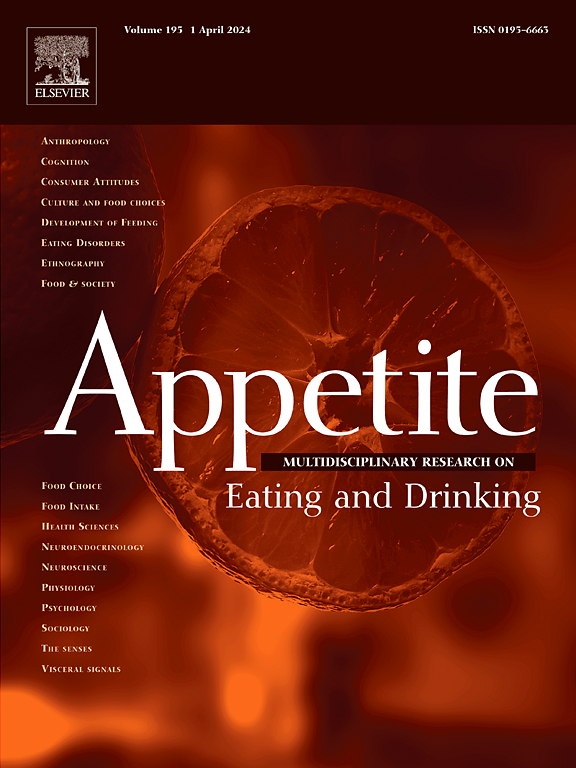外出就餐时如何选择餐食?一项关于消费者在餐厅选择食物策略的混合方法研究。
IF 4.6
2区 医学
Q1 BEHAVIORAL SCIENCES
引用次数: 0
摘要
在餐馆选餐是生活的重要组成部分。在全球超过 1750 万家餐饮店中,人们平均每周购买七餐。人们选择餐厅就餐的方式不同于他们选择在家食用的食物的方式。了解人们在选择餐厅用餐时的决策策略,对于设计行为改变干预措施,促使人们做出特定的食物选择(如健康、低排放)至关重要。我们的研究旨在识别各种餐饮店的就餐选择策略(研究 1),并确定其使用频率(研究 2)。在研究 1 中,我们从建构主义角度出发,通过 21 个半结构式访谈,了解人们在不同餐饮店选择膳食时使用的策略。我们发现了 16 种不同的策略,许多人在不同类型的餐厅(即普通餐厅、快餐店、酒吧和高档餐厅)内和餐厅之间使用多种策略。在研究 2 中,我们量化了这 16 种策略中哪些最常用。使用最多的策略是在菜单上搜索(1)最喜欢的餐点,(2)最经济实惠的餐点,或(3)熟悉的餐点(即习惯性选择),并从中做出选择。很少有人在菜单上搜索最环保的餐食并从中选择。这些结果可以解释餐厅碳标签的有限有效性。我们的研究呼吁,未来有关促使人们选择环保或健康食品的干预措施应摒弃健康和环境标签,而将重点放在享受、价格或习惯上,因为这些对人们选择膳食非常重要。我们还创建了 16 种食物选择策略的实用测量方法,供研究人员使用。本文章由计算机程序翻译,如有差异,请以英文原文为准。
How do you choose your meal when you dine out? A mixed methods study in consumer food-choice strategies in the restaurant context
Choosing meals in restaurants is a significant part of life. On average, people purchase seven meals per week from one of the over 17.5 million food outlets worldwide. The way people choose restaurant meals is different from how they choose foods they consume at home. Understanding people's decision-making strategies when choosing restaurant meals is critical for designing behaviour change interventions that prompt specific food choices (e.g., health, low emissions). Our study aims to identify meal choice strategies across various food outlets (Study 1) and determine their frequency of use (Study 2). In Study 1, we take a constructionist perspective and derive insights from 21 semi-structured interviews on strategies people use as they select meals in different food outlets. We identify 16 distinct strategies, with many people using multiple strategies within and across different restaurant types (i.e., general restaurants, fast-food, pubs, and upscale restaurants). In Study 2, we quantify which of those 16 strategies are most frequently used. The most used strategies were searching the menu for (1) the most enjoyable meals, (2) the most budget-friendly meals, or (3) familiar meals (i.e., habitual choices); and choosing from those. Few people searched the menu for the most environmentally friendly meals and chose from those. These results could explain the limited effectiveness of carbon labelling at restaurants. Our study calls for future interventions on prompting environmental or healthy food choices to move away from health and environmental labelling and to focus on enjoyment, price, or habit because these are important for people when choosing a meal. We also created a practical measure of the 16 food-choice strategies, available for researchers to use.
求助全文
通过发布文献求助,成功后即可免费获取论文全文。
去求助
来源期刊

Appetite
医学-行为科学
CiteScore
9.10
自引率
11.10%
发文量
566
审稿时长
13.4 weeks
期刊介绍:
Appetite is an international research journal specializing in cultural, social, psychological, sensory and physiological influences on the selection and intake of foods and drinks. It covers normal and disordered eating and drinking and welcomes studies of both human and non-human animal behaviour toward food. Appetite publishes research reports, reviews and commentaries. Thematic special issues appear regularly. From time to time the journal carries abstracts from professional meetings. Submissions to Appetite are expected to be based primarily on observations directly related to the selection and intake of foods and drinks; papers that are primarily focused on topics such as nutrition or obesity will not be considered unless they specifically make a novel scientific contribution to the understanding of appetite in line with the journal's aims and scope.
 求助内容:
求助内容: 应助结果提醒方式:
应助结果提醒方式:


